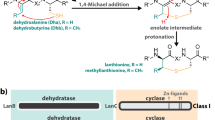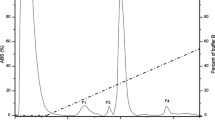Abstract
The aim of this study was to elucidate the structure and possible function of colostrinin, also known as a proline rich polypeptide (PRP). The molecular weight of colostrinin was originally determined by gel filtration to be 17,200 daltons. In the presence of guanidinum chloride, however, the molecular weight was found to be about 6,000 daltons. Further studies utilizing high-performance liquid chromatography (HPLC) and mass spectroscopy revealed that colostrinin is a complex consisting of many low molecular-weight polypeptides. A total of 32 peptides were isolated from the original colostrinin preparation by HPLC and subjected to the N-terminal sequence analysis. The results of sequence analysis revealed significant homology of the peptides to three protein precursors: annexin, β-casein, and a hypothetical β-casein homolog. In addition, the sequence of several peptides showed no significant homology to any specific protein in the current GenBank database. The synthetic peptides of various lengths representing the N-terminal sequence of the colostrinin peptides were made to study some biological effects. Here we report that colostrinin and some of its component peptides are potent inducers of leukocyte proliferation and of certain cytokines. Also, a series of monospecific antibodies were produced in rabbits against the synthetic peptides. The antibodies were used to study the kinetic of antigen reduction in colostrum and mature milk following lambing. A threefold decrease was common for most antigens studied over the period of 72 h. Based on the results of these studies we postulate that colostrinin represents a diverse group of peptides produced in the mammary gland of mammals for the development of the optimal physiologic responses in offspring. Also, it is hoped that the beneficial use of colostrinin in Alzheimer’s Disease (AD), recently reported elsewhere, will revive interest in its clinical application for treatment and/or prophylaxis of many age-related disorders.
Similar content being viewed by others
References
Ariyoshi Y. (1993) Angiotensin-converting enzyme inhibitors derived from food proteins. Trends Food Sci. Technol. 4, 139–144.
Baintner I. (1986) Intestinal Absorption of Macromolecules and Immune Transmission from Mother to Young. CRC Press, Boca Raton, FL.
Blach-Olszewska Z. and Janusz M. (1997) Stimulatory effect of ovine colostrinin (a Proline-Rich-Polypeptide) on interferons and tumor necrosis factor production by murine resident peritoneal cells. Arch Immunol. Ther. Exp. 45, 43–47.
Boldogh I., Hughes T. K, Georgiades J., and Stanton J. (2001) Antioxidant and cell-differentiating activity of colostrinin and its component peptides (CCPs) in cell culture. Psychogeriatr. Ann. 4, 57–65.
Drouet L. and Caen J. (1993) Biologically active peptides from milk proteins with emphasis on two examples concerning antithrombotic and immunomodulating activities. J. Dairy Sci. 76, 301–310.
Chan C. C. and White P. D. (eds.) (2000) Fmmoc Solid Phase Peptide Synthesis. A practical Approach. Oxford University Press, UK.
Goldman A. S. (1993) The immune system of human milk: antimicrobial, antiinflammatroy and immunomodulating properties. Pediatr. Infect. Dis. J. 12, 664–671.
Hirayama M., Toyota K., Hidaka H., and Naito H. (1992) Phosphopeptides in rat intestinal digests after ingesting casein phosphopeptides. Biosci. Biotech. Biochem. 56, 1128–1129.
Ho B. (1988) Prolactin in human milk: the influence of nursing and duration of postpartum lactation. Am. J. Obstet. Gynecol. 158, 583–585.
Inglot A. D., Janusz M., and Lisowski J. (1996) Colostrinin: a proline-rich polypeptide from ovine colostrums is a modest cytokine inducer in human leukocytes. Arch. Immunol. Ther. Exp. 44, 215–224.
Inglot A., Gelder F., and Georgiades J. A. (1998) Tumor-associated antigens are cytokine inducers and hypore-activity factors to the immune system. Biotherapy 11, 27–37.
Janusz M., Lisowski J., and Francek F. (1974) Isolation and characterization of a proline-rich polypeptide from ovine colostrums. FEBS Lett. 49, 276–279.
Janusz M., Staroscik K., Zimecki M., Wieczorek Z., and Lisowski J. (1981) Chemical and physical characterization of proline-rich polypeptide from sheep colostrum. Biochem. J. 199, 9–15.
Janusz M. and Lisowski J. (1993) Proline-rich polypeptide (PRP)- an immunomodulatory peptide from ovine colostrum. Arch. Immunol. Ther. Exp. 41, 275–279.
Kruzel M., Harari Y., Chen C. Y., and Castro A. G. (1998) The gut: a key metabolic organ protected by lactoferrin during experimental systemic inflammation in mice, in AEMB 443, Advances in Lactoferrin Research (Spik G. et al., eds.), Plenum Press, New York, pp. 167–173.
Kruzel M., Zagulski T., and Zimecki M. (1999) Lactoferrin and insult-induced metabolic imbalance. Proceedings, 4th International Conference on Lactoferrin: Structure, Function and Applications (Shimazaki, K., ed.), Elsevier, Amsterdam, pp. 301–310.
Kruzel M., Harari Y., Chen Y., and Castro A. G. (2000) Lactoferrin protects gut mucosal integrity during endotoxemia induced by lipopolysaccharide in mice. Inflammation 24, 33–44.
Kruzel M. and Georgiades J. (2001) Colostrinin: a new frontier for an old structure. Psychogeriatr. Ann. 4, 77–80.
Lahov E. and Regelson W. (1996) Antimicrobial and immunostimulating casein-derived substances from milk: casecidin, isracidin peptides. Food Chem. Toxic. 34, 131–145.
Lee Y. S., Noguchi T., and Naito H. (1980) Phosphopeptides and soluble calcium in the small intestine of rats given a casein diet. Br. J. Nutr. 43, 457–467.
Leszek J., Inglot A. D., Janusz M., Lisowski J., Krukowska K., and Georgiades J. A. (1999) Colostrinin: a proline-rich polypeptide (PRP) complex isolated from ovine colostrums for treatment of Alzheimer’s disease. A double-blinded, placebo-controlled study. Arch. Immunol. Ther. Exp. 47, 377–385.
Leszek J., Bidzan L., Bilikiewicz A., Kiejna A., Janusz M., Dubowska-Inglot A., et al. (2000) Colostrinin: possibility of application in treatment of Alzheimer’s disease. Psychogeriatr. Ann. 3, 13–23.
Piasecki E., Inglot A. D., Winiarska M., Krukowska K., Janusz M., and Lisowski J. (1997) Coincidence between spontaneous release of interferon and tumor necrosis factor by colostral leukocytes and the production of a colostrinin by human mammary gland after normal delivery. Arch. Immunol. Ther. Exp. 45, 109–117.
Rasmussen P. H., Ramanujam P. S., Hvilsted S., and Berg R. H. (1999) A remarkably efficient azobenzen peptide for holographic information storage. J. Am. Chem. Soc. 121, 4738–4743.
Sanchez-Pozo A., Lopez J., Pita M. L., Izquierdo A., Guerrero E., Sanchez-Medina F., et al. (1986) Changes in the protein fractions of human milk during lactation. Ann. Nutr. Metab. 30, 15–20.
Schlimme E. and Meisel H. (1995) Bioactive peptides derived from milk proteins. Structural, physiological and analytical aspects. Die Nahrung 39, 1–20.
Stanton J., Boldogh I., Georgiades J., and Hughes T. K. (2001) Induction of proliferation and cytokines colostrinin and component proline rich peptides in human peripheral blood leukocytes. Psychogeriatr. Ann. 4, 67–75.
Staroscik K., Janusz M., Zimecki M., Wieczorek Z., and Lisowski J. (1983) Immunologically active nonapeptide fragment of a proline-rich polypeptide from ovine colostrum: amino acid sequence and immunomodulatory properties. Mol. Immunol. 20, 1277–1282.
Wong C. W., Seow H. F., Liu A. H., Husband A. J., Smithers G. W., and Watson D. J. (1996) Modulation of immune responses by bovine β-casein. Immunol. Cell Biol. 74, 323–329.
Yamauchi K. (1992) Biologically functional proteins of milk and peptides derived from milk proteins. IDF Bull. 272, 51–58.
Zablocka A., Janusz M., Rybka K., Miecznikowska H., Kupryszewski G., Wirkus-Romanowska I., and Lisowski J. (2000) Cytokine induction by proline-rich polypeptide complex and analogues of its active nonapeptide. Final Report to the Polish Academy of Sciences: KBN No. 6PO4B01311.
Zimecki M., Lisowski J., Hraba T., Wieczorek Z., Janusz M., and Staroscik K. (1984) The effect of a proline-rich polypeptide (PRP) on humoral immune response. I. Distinct effect of PRP on the cell properties of mouse glass-nonadherent (NAT) and glass adherent (GAT) thymocytes in thymectomized mice. Arch. Immunol. Ther. Exp. 32, 191–196.
Zimecki M., Lisowski J., Hraba T., Wieczorek Z., Janusz M., and Staroscik K. (1984) The effect of a proline-rich polypeptide (PRP) on humoral immune response. II. PRP induces differentiation of helper cells from glass-nonadherent (NAT) and suppresor cells from glass-adherent (GAT) thymocytes. Arch. Immunol. Ther. Exp. 32, 197–201.
Author information
Authors and Affiliations
Corresponding author
Rights and permissions
About this article
Cite this article
Kruzel, M.L., Janusz, M., Lisowski, J. et al. Towards an understanding of biological role of colostrinin peptides. J Mol Neurosci 17, 379–389 (2001). https://doi.org/10.1385/JMN:17:3:379
Received:
Accepted:
Issue Date:
DOI: https://doi.org/10.1385/JMN:17:3:379




